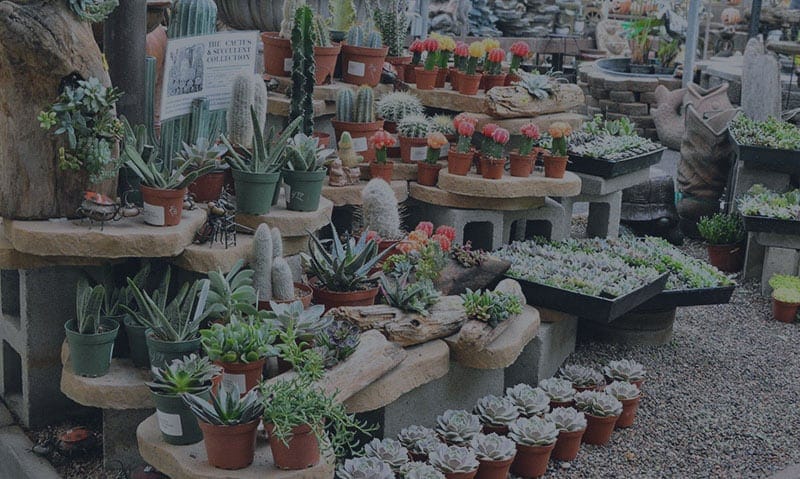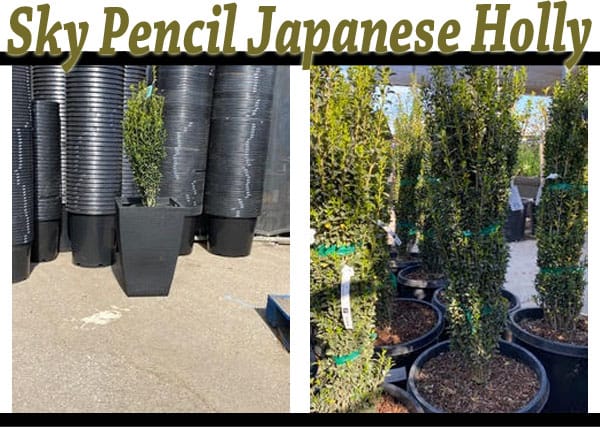Newsletter Articles
Sky Pencil Japanese Holly
By Richard Flowers, ACCNP-Green Thumb Nursery-Ventura
Do you have a difficult area in your landscape where it is between two buildings with a narrow strip of soil for planting and you want to block the view of your neighbors or something unsightly? Your choices of plant material are limited for this type of application unless you routinely prune the plant so it does not get in the way of the nearby walkway or become too overgrown and unmanageable.
Do I have good news for you because your problem may be solved by using Sky Pencil Japanese Holly. This subject would be a perfect plant for this application because it is well behaved and only grows no more than 3 feet wide and as tall as 10 feet slowly, over time. It doesn’t need a whole lot of pruning, it grows tight, compact and columnar. Its dark green mature leaves and form give the plant a formal and clean look all the time.
The botanical name for Sky Pencil Japanese Holly is Ilex crenata and is native to the forests, thickets, and mountain slopes of Japan, Korea, China and Eastern Russia.
The cultivar ‘Sky Pencil’ is an introduction from the U.S. National Arboretum in Washington, D.C. The main virtue this plant has is an exceedingly narrow, fastigiate form which grows in a vertical, pencil-like (hence the cultivar name) column that could be used for a narrow screening or a vertical accent. Sky Pencil Japanese Holly is related to the traditional Christmas Holly that provides you red berries and dark green
spiny leaves. However this Holly is not like your traditional Holly because it does not have sharp, spiny leaves, which is essentially the definition of what the species-‘crenata’ means but instead it has small, fine rounded teeth. Ilex means any plant related to Ilex or Holly. Like all other hollies, it does produce a berry only if it is pollinated by a compatible male (‘Sky Pencil’ is female) Holly but the berries are really small and not the main virtue of the plant.
This non-traditional Holly grows best in USDA Zones 5 – 9 meaning it does well in our area and is adaptable to growing in western climates and tolerates air pollution. It prefers to grow in a cool, slightly acid soil that is well drained. I highly recommend using Acid Planting Mix or Azalea Camellia Mix when planting this species to help acidify your oil and to use an acid based fertilizer like Cotton Seed Meal or other acid fertilizer
according to label directions to help maintain acidity. Mulching is imperative to help keep the soil cool, keep down weeds, reduce water loss through evaporation, and help improve soil structure as it breaks down. It would enjoy being planted in full sun to partial shade especially in hot interior locales and kept out of the wind. The more sun it receives the more compact and less open or floppy it becomes. Provide regular water and irrigate regularly – weekly, or more often in extreme heat or containers.
Established plants have little tolerance to drought. Sky Pencil Japanese Holly has a strong columnar shape and to maintain its form it is suggested to prune accordingly. When pruning, it is wise to do it during wintertime and prune only poorly placed, way-ward or broken branches so the plant can fill in. If your Holly develops ragged and open growth you can shorten the branches so the plant has an opportunity to fill in below the cuts you made. Prune annually to shape.
Sky Pencil Japanese Holly can be used as an alternative to the everyday / normal screening / hedging plants like Japanese Boxwood( Buxus), Wax Leaf Privet (Ligustrum), Brush Cherry(Eugenia), and Hopseed Bush (Doddonea) because it doesn’t need the upkeep like the other ones do in narrow or limited spaces. This easy to grow plant is useful as privacy hedge or windbreak when planted close together to form a solid background. For a solid screen, plant as close as 2 feet apart (measuring from trunk to trunk.) The plants will grow together in time. Sky Pencil Japanese Holly
stays neat year-round and the leaves lack sharp points, making it ideal for decks, patios, or entryways as a formal looking specimen or privacy screening. It also makes a superb statement in containers. This species works outstanding when used in contemporary or formal looking pots or decorative wooden boxes for the porch, patio, and terrace. This choice plant is prized for its evergreen foliage is also very effective when used in pairs to flank a wall fountain, sculpture or frame a doorway. The structure and exceptional architectural that this selection provides would be ideal for a formal looking entryway or Asian / Zen garden. Don’t forget you can also use this plant as a divider or separator between two different gardens. It looks fantastic when used with Begonias, Ferns, Impatiens, Heavenly Bamboo (Nandina), Azaleas, Roses, and so much more, just use your imagination. Use a single specimen plant in your perennial bed at a curve or bend to mark the moment of transition or use it as a repeating design
element to give a strong structure to your design.
I encourage to stop by your favorite Green Thumb Nursery and check out these awesome plants, and other cool things.
Do you like what you see? Sign up for our weekly newsletter to get content like this every week!


